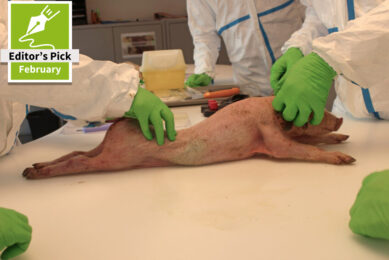Researchers propose new definition of gut health

The concept of gut health has started to attract significant interest within the animal science community, however a clear definition of gastrointestinal health and functionality and how it can be measured is lacking.
This is according to a (open access) review paper by Celi et al, published in Animal Feed Science and Technology. According to the authors, the term ‘gut health’ has gained significant interest when researchers started to question whether the farm animal performance reached its genetic/physiological limits. At the same time, a clear definition of gut health is lacking, and this is crucial to be able to measure it and to test for example, whether nutritional interventions have an effect on it.
3 components of gut health
Conway (1994) proposed 3 components of gut health namely the diet, the mucosa, and the commensal flora. Based on this theory, the authors of the paper propose the definition of gut health as ‘a steady state where the microbiome and the intestinal tract exist in symbiotic equilibrium and where the welfare and performance of the animal is not constrained by intestinal dysfunction’. This definition combines the principal components of gut health, namely diet, effective structure and function of the GIT barrier and normal and stable microbiota, with effective digestion and absorption of feed and effective immune status. According to the authors, all these components play a critical role in GIT physiology, animal health, welfare (including animal behaviour) and performance.
Effect of diet on GI tract
If we look at one of the components, diet, in more detail the paper mentions many dietary factors that impact the health of the GI tract of non-ruminant farm animals (Klasing, 1998). Such factors include certain types of dietary fibre (DF), trypsin inhibitor, phytate, lectins, undigested protein in the distal GI tract, mycotoxins, pathogenic and putrefactive microorganisms, diets with poor nutrient balance, temperature stresses, poor water quality, certain vaccination programmes and many others (Klasing, 1998). These antinutrients potentially can compromise to various degrees the physiological, histological and consequently the functional integrity of the gut. Techniques such systematic processing of feeds and feed ingredients using manipulated variations of temperatures, humidity, pressure and combinations thereof are currently being deployed on those that are temperature labile. The rest of the factors can, also to varying extents, be controlled by feed additives and supplements.
Need for reference panel biomarkers
Clarity of understanding of gut health will require the characterisation of the interactions between these components. Biomarkers (in the form of certain metabolites that are releases in the GIT) are therefore important. An inventory of possible gut health biomarkers has been made for use in pigs and poultry (Niewold, 2015), however, the overall lack of information on gut health biomarkers in farm animals is remarkable. A main challenge in the development of gut health biomarkers is that the same biomarkers are not present in all the species: MPO, haptoglobin and citrulline are not found in chicken (Niewold, 2015). In addition, many reagents needed for the development of dedicated assays are not available or they haven’t been validated in the species of interest. These challenges hinder the progress of our knowledge in this area. Future research should therefore focus on the establishment of a reference panel of biomarkers of gut health to be used in farm animals. In addition, it should also address the issue of standardisation of techniques and methodologies to study gut health. For example, tissue biopsy sampling techniques can be utilised only in particular cases in the field, therefore a major challenge in gut health research is to develop a set of non-invasive biomarkers that can reliably reflect gut health status. There are numerous techniques that can be used to measure gut health (Bischoff et al., 2014; Niewold, 2015; Verbeke et al., 2015), however animal scientists need to establish whether biomarkers measured in blood, faeces, urine and breath provide a reasonable index of gut health.











